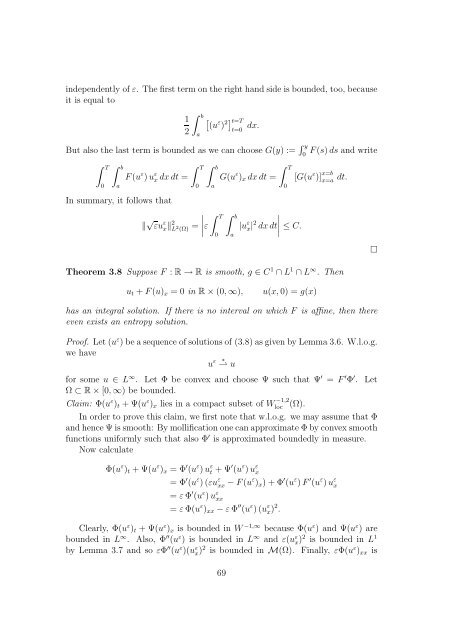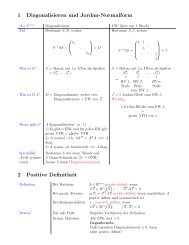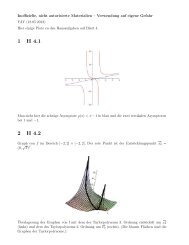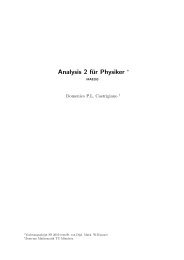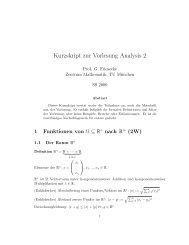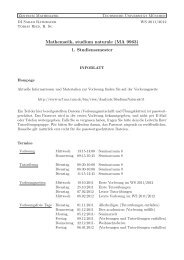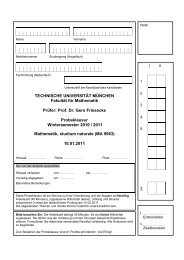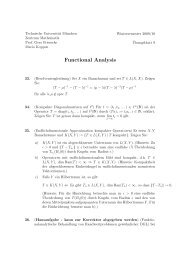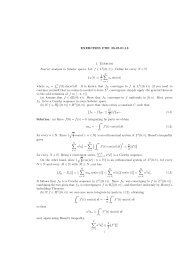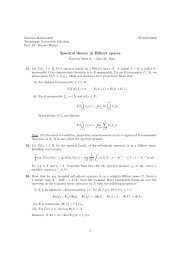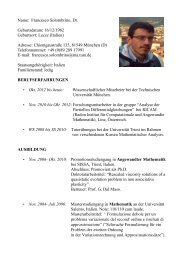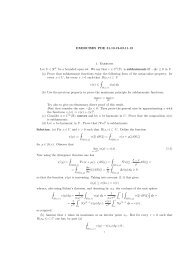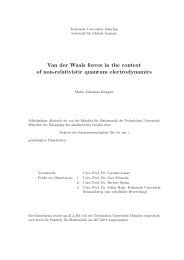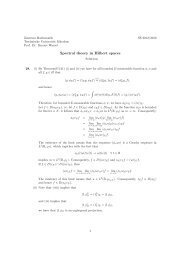Weak Convergence Methods for Nonlinear Partial Differential ...
Weak Convergence Methods for Nonlinear Partial Differential ...
Weak Convergence Methods for Nonlinear Partial Differential ...
Erfolgreiche ePaper selbst erstellen
Machen Sie aus Ihren PDF Publikationen ein blätterbares Flipbook mit unserer einzigartigen Google optimierten e-Paper Software.
independently of ε. The first term on the right hand side is bounded, too, because<br />
it is equal to<br />
1<br />
2<br />
∫ b<br />
a<br />
[<br />
(u ε ) 2] t=T<br />
t=0 dx.<br />
But also the last term is bounded as we can choose G(y) := ∫ y<br />
0<br />
F(s) ds and write<br />
∫ T ∫ b<br />
0<br />
a<br />
F(u ε ) u ε x dxdt =<br />
∫ T ∫ b<br />
In summary, it follows that<br />
‖ √ ∣ ∫ ∣∣∣ T<br />
εu ε x‖ 2 L 2 (Ω) = ε<br />
0<br />
0<br />
a<br />
G(u ε ) x dxdt =<br />
∫ b<br />
a<br />
∫ T<br />
|u ε x| 2 dxdt<br />
∣ ≤ C.<br />
0<br />
[G(u ε )] x=b<br />
x=a dt.<br />
□<br />
Theorem 3.8 Suppose F : R → R is smooth, g ∈ C 1 ∩ L 1 ∩ L ∞ . Then<br />
u t + F(u) x = 0 in R × (0, ∞),<br />
u(x, 0) = g(x)<br />
has an integral solution. If there is no interval on which F is affine, then there<br />
even exists an entropy solution.<br />
Proof. Let (u ε ) be a sequence of solutions of (3.8) as given by Lemma 3.6. W.l.o.g.<br />
we have<br />
u ε ∗ ⇀ u<br />
<strong>for</strong> some u ∈ L ∞ . Let Φ be convex and choose Ψ such that Ψ ′ = F ′ Φ ′ . Let<br />
Ω ⊂ R × [0, ∞) be bounded.<br />
Claim: Φ(u ε ) t + Ψ(u ε ) x lies in a compact subset of W −1,2<br />
loc<br />
(Ω).<br />
In order to prove this claim, we first note that w.l.o.g. we may assume that Φ<br />
and hence Ψ is smooth: By mollification one can approximate Φ by convex smooth<br />
functions uni<strong>for</strong>mly such that also Φ ′ is approximated boundedly in measure.<br />
Now calculate<br />
Φ(u ε ) t + Ψ(u ε ) x = Φ ′ (u ε ) u ε t + Ψ′ (u ε ) u ε x<br />
= Φ ′ (u ε ) (εu ε xx − F(uε ) x ) + Φ ′ (u ε ) F ′ (u ε ) u ε x<br />
= ε Φ ′ (u ε ) u ε xx<br />
= ε Φ(u ε ) xx − ε Φ ′′ (u ε ) (u ε x )2 .<br />
Clearly, Φ(u ε ) t + Ψ(u ε ) x is bounded in W −1,∞ because Φ(u ε ) and Ψ(u ε ) are<br />
bounded in L ∞ . Also, Φ ′′ (u ε ) is bounded in L ∞ and ε(u ε x )2 is bounded in L 1<br />
by Lemma 3.7 and so εΦ ′′ (u ε )(u ε x) 2 is bounded in M(Ω). Finally, εΦ(u ε ) xx is<br />
69


